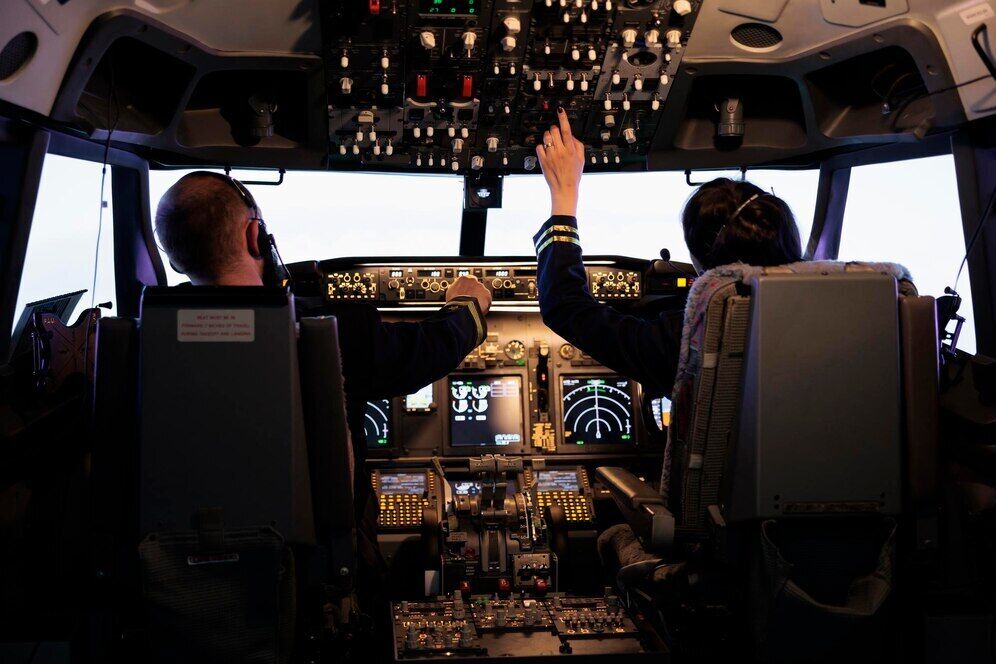Experts have shared how to cope with turbulence

If turbulence makes you nervous, you're definitely not alone. It is one of the many triggers of aviophobia, or fear of flying. A 2015 Economist/YouGov survey found that 40 percent of Americans are "somewhat bothered" by airplane travel, and 15 percent are afraid of it.
"I've never met anyone who likes turbulence, and unexpected turbulence is even worse for those who fear it," David Rimmer, CEO of AB Aviation Group, tells Travel + Leisure. Rimmer is not only an advocate for flight safety but also a survivor of a mid-air collision.
While turbulence tends to be a concern for nervous pilots, it poses very little threat to the safety of modern aircraft. Here's everything you need to know to deal with the fear of turbulence.
It's worth learning more about turbulence
Turbulence, sometimes referred to by pilots as "rough air," is simply air moving in an unusual, unexpected, or chaotic way. It can be caused by a variety of things, from thunderstorms to changes in atmospheric pressure and air movement in and around mountains—and it can happen even when conditions appear perfectly clear.
According to the U.S. National Weather Service, turbulence is typically categorized into four levels of severity: mild, moderate, severe, and extreme. Mild turbulence is the most common, and in a commercial airplane, it is felt only as a slight jolt or wobble. Moderate turbulence is much less common, and this type of turbulence can be a bit more abrupt, to the point where your drink may spill.
Severe turbulence is very rare, but if it does occur, it can injure passengers or crew who are not fastened to their seats—this is the type of turbulence that is often discussed on social media. Severe turbulence is almost never observed, but when it does occur, it causes strong movements in the cabin and loss of control over the aircraft. At the same time, severe turbulence most often occurs around severe thunderstorms, which aircraft now avoid thanks to advanced weather forecasting technologies.
Although turbulence can occur unexpectedly, pilots keep in touch with each other in the air. If one is experiencing turbulence, a message is relayed to all those flying behind, allowing other aircraft to change course to find calmer air, often at a slightly different altitude. If the turbulence is unavoidable, the captain will ask passengers and flight attendants to buckle up.
What are the dangers of turbulence?
Turbulence has never been the only factor in an airplane crash, although in the early days of aviation, it was a much greater threat than it is today. Airplanes are designed to handle mild to moderate turbulence with ease, just as a car is designed to handle bumpy roads or a boat is designed to handle rough seas.
While you don't need to worry about the structural components of the airplane, you should be concerned about your safety inside the airplane during turbulence. According to the U.S. Federal Aviation Administration (FAA), from 2009 to 2022, 163 people were seriously injured due to turbulence, 129 of them crew members. "The most common and severe in-flight injuries are sustained by flight attendants because they spend the least amount of time sitting up and wearing seat belts," says Rimmer. He advises passengers to "sit as much as possible, always wear your seatbelt, and never get up when the 'Fasten seatbelt' sign is on to prevent turbulence-related injuries.
Strategies to overcome the fear of turbulence
If the thought of turbulence makes you anxious, here are some steps you can take before and during your flight to reduce your fears.
Avoid seats in the back of the plane
"The turbulence will be much stronger in the back of the airplane, including jolts and side-to-side rocking, or yawing," says Rimmer.
Listen to your pilots
Most pilots provide passengers with a weather forecast before takeoff, so listen to any announcements on the loudspeaker as you land. During the flight, always listen to the crew's warnings about turbulence—stay in your seat and fasten your seat belts if they ask you to.

Practice groundingtechniques
"Grounding techniques are one of the most useful tactics for alleviating anxiety because they allow you to focus on your body and think less about what's going on in your head," says Mark Debus, a clinical manager of mental health services and licensed clinical social worker. "To do this, you need to use as many of your senses as possible: sight, touch, smell, and hearing."
He advises focusing on an object in front of you, such as a curtain or exit sign, and then lightly touching something solid, such as an armrest. At the same time, see if you can smell anything around you, from snacks to a passenger's perfume. Then listen to any conversation around you, paying attention to the tone of voice, not the words.
You can also use repetitive breathing exercises to ground yourself. "In addition to serving as a reminder to breathe, rhythmic breathing can have a calming effect on the body: a person usually starts to feel calmer within 30 seconds of starting the exercise," says Debus. He advocates the 3-3-3 method: "First, you slowly inhale through your nose for three seconds, hold your breath for a count of three, exhale through your mouth for a count of three, wait for a count of three, then repeat."
If your seatmate is nervous, talk to them
Talking to your neighbor can help you both take your minds off the turbulence. "One of the benefits of helping others is that it also helps you deal with your own anxiety," says Debus. If your seatmate is a stranger, introduce yourself in a calming voice. "Maybe talk about your travel destination. Ask them what they plan to do upon arrival. Ask if they have pets or children," says Debus.



















